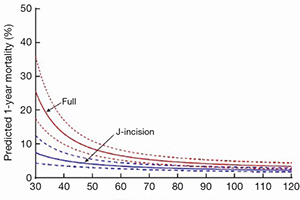Minimally invasive aortic valve surgery: Cleveland Clinic experience
Abstract
Background: Minimally invasive surgery has become a routine approach for aortic valve disease over the last 18 years at the Cleveland Clinic. It is conducted in isolation or in combination with other procedures. The objectives of this study are to review trends and outcomes in these patients.
Methods: Cleveland Clinic Cardiovascular Information Registry (CVIR) was searched for aortic valve procedures from 1996 to 2013. All patients undergoing isolated or combined aortic valve operations were included for analysis. The incision type and procedure type were reviewed and trends were evaluated over time. Cleveland Clinic outcomes with minimally invasive approaches to the aortic valve are reviewed.
Results: A total of 22,766 aortic valve surgical procedures were performed in this 18-year timeframe. Of these, 3,385 (14.9%) were minimally invasive procedures (MIPs) and 2,379 (10.5%) were isolated minimally invasive aortic valves. MIPs increased from 12.4% to 29.6% of the total aortic valve volume over the period of the study. Combined procedures, including concomitant surgery on the aorta, mitral valve, tricuspid valve, and arrhythmia surgery increased over time as well. Overall mortality for primary and reoperative aortic valve operations continues to decline and has consistently been less than 1% for several years.
Conclusions: A programmatic approach to minimally invasive aortic valve surgery (MIAVS) with careful patient selection, appropriate use of preoperative imaging, and selective conversion to sternotomy when necessary, allows for aortic valve replacement (AVR) and a wide range of concomitant procedures to be performed safely in a large number of patients.
Cover






